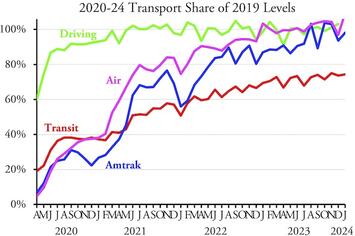
Driving and flying have been hovering around 100 percent of pre-pandemic levels for the last year and Amtrak has been around 100 percent for the last six months, but transit is still stuck at just below 75 percent, according to monthly data released by the Federal Transit Administration yesterday. Transit first reached 73 percent last March and 74 percent in September, and even exceeded 75 percent in November (a month that had more business days in 2023 than 2019), but it doesn’t look like it will get significantly above 75 percent for a long time.
The results vary by urban area, of course. Above-average areas include New York (80.5%), Miami (90.5%), Washington (80.6%), San Diego (80.6%), Tampa-St. Petersburg (83.4%), Las Vegas (83.6%), Cincinnati (96.7%), Austin (82.8%), and Richmond (113.1%). Remaining well below average are Chicago (62.6%), Atlanta (53.0%), Boston (62.0%), Detroit (54.7%), Phoenix (50.4%), San Francisco-Oakland (59.0%), St. Louis (58.6%), Pittsburgh (54.5%), and Jacksonville (56.9%).
Any transit agency planning major improvements needs to reduce its forecasts to account for post-pandemic changes in travel patterns. That means, at the very least, that if an agency has recently been carrying 75 percent of pre-pandemic numbers, all ridership forecasts should be reduced by 25 percent. Much better would be if agencies recognize that the urban areas they serve are no longer monocentric and completely redesign their transit networks to serve multiple economic centers.
Transit has not fully recovered from the pandemic largely because so many people are working from home and such remote working had impacted transit more than driving. This is true for two reasons: first, a high percentage of pre-pandemic transit riders were downtown office workers and these are the most likely people to have shifted to working from home. Second, many transit riders before the pandemic were using transit to avoid congestion, but increased telecommuting has reduced congestion allowing more people who don’t work at home to drive to work.
The latest data on remote working indicates that, on any given day in January, about 29 percent of people were working from home. These data were collected using an on-line survey and the researchers who collected them admit that the survey may undercount people who only have high school diplomas or are otherwise less tech-savvy.
Whether the exact number is 29 percent or a little less, what remains important is that the share working from home in monthly surveys has hovered around 29 percent since at least August of 2022, suggesting that it is not going to change significantly in the future. This in turn means that transit ridership isn’t going to change significantly either.
Unfortunately, neither of those are likely to happen anytime soon. With billions of dollars to give away, the Federal Transit Administration doesn’t even seriously care what ridership forecasts say. And with transit agencies getting millions to billions of dollars regardless of actual ridership, they don’t seriously care if they serve more than a tiny fraction of the people in their regions or not.
The Antiplanner has posted an enhanced version of the Federal Transit Administration’s monthly database. The FTA’s raw data are in cells A1 through JO2288. Annual totals from 2002 through 2023 are in columns JP through KL. Column KM compares January 2024 with January 2019. Column KN compares January 2024 with January 2023.
National and mode totals are in rows 2290 through 2309. To show New York’s importance, row 2314 shows the percentage share of ridership that takes place in the New York urban area. Transit agency totals are in rows 2330 through 3319. Urban area totals are in rows 3321 through 3811. These enhancements are on the ridership (UPT for unlinked passenger trips) and service (VRM for vehicle-revenue-miles) worksheets. I hope you find this spreadsheet useful.
Read the rest of this piece at The Antiplanner.
Randal O'Toole, the Antiplanner, is a policy analyst with nearly 50 years of experience reviewing transportation and land-use plans and the author of The Best-Laid Plans: How Government Planning Harms Your Quality of Life, Your Pocketbook, and Your Future.
Graph: When measured as a percent of pre-pandemic travel, transit continues to lag well behind all other modes of travel. Highway data for January 2024 should be available soon. Courtesy, The Antiplanner.












